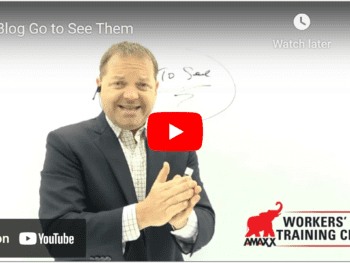
Implementing Change Before the Work Injury
Employers and insurance carriers can reduce workers’ compensation costs by implementing an effective communication strategy before someone gets injured on the job. Now is the time to examine your program and implement change geared toward better communication.
Click Link to Access Free PDF Download
“9-Element Blueprint To Create Your Workers’ Comp Employee Brochure”
- Work Comp Informational Brochure: Many employers and insurance carriers do not have a brochure regarding workers’ compensation. Creating a company-specific brochure can increase workplace morale to demonstrate a commitment to education and return to work. This brochure can incorporate easy-to-follow flowcharts that explain what an injured employee can expect following a work injury and basic information on the workers’ compensation benefit scheme.
- Develop Company Culture: Using a company’s logo – branding – and associating it with safety can pay dividends in the future. Consider updating the company’s mission statement to include an identity geared toward employees and a commitment to workplace safety.
- Highlight Return to Work: This information should be included in a company onboarding process. All employees must understand the company’s commitment and philosophy to getting someone back to work following a work injury. This should also be reflected in the company’s reporting structure, culture, and practices.
There are countless ways to improve communication before a work injury. Now is the time for a company level-set that focuses on workplace safety and employee commitment.
Communicate, Communicate, Communicate Post-Injury
Workplace injuries are unavoidable. Once they happen, employers and other interested stakeholders must communicate with the employee. This is because the claim and events that follow are important to the most critical person in a claim – the employee.
- Wallet Cards: Provide the injured employee with a wallet size contact card. Information to include on this card should relate directly to the work injury. Important date points are the name and policy number of the workers’ compensation policy for the employer, claim handler contact information, the name of the employer’s preferred health provider network, and employer contacts related to return to work;
- Empathetic Post-Injury Responses: Every supervisor and manager should be encouraged to contact employers under supervision following an injury. This should include a follow-up telephone call to check on the employee’s status and consider sending a “get well soon” card. There is also nothing wrong with visiting an injured employee at a hospital should they require ongoing medical care. Anything done to increase employee morale is helpful.
- Do Not Forget Accessibility: Information must be accessible to all employees without regard to their ability or primary language. All services should be in conformance with the Americans with Disabilities Act. While it might not necessarily be required, all workers’ compensation education and post-injury materials should be in Spanish and other native languages unique to a workforce.
You can never communicate too much following a work injury. Communication drives engagement, prevents issues from arising, and can increase employee morale. Now is the time to evaluate how you are communicating following a work injury and look for opportunities to increase and improve the level of engagement.
Schedule Weekly Meetings to Drive Return to Work
Communication is an ongoing process following a work injury. It needs to be ongoing to ensure nothing falls between the cracks. Here are some ideas to improve the nature and frequency of regular communications with the employee after an injury:
- Consider scheduling meetings at the employer’s facility;
- Include all interested stakeholders, including supervisors and nurse cage managers;
- Continuing to verify work restrictions, ongoing medical care, and need for additional medical care; and
- Return to work should be a focus on all weekly meetings.
Now is the time to schedule a weekly meeting with an injured employee within your organization.
Conclusions
Communication in workers’ compensation can reduce program costs and improve return to work rates by spending little to no money. Interested stakeholders should consider what they are doing before the workplace incident. Other considerations should include steps taken following an injury and setting up weekly meetings with the injured employee. Implementing these strategies will give program efficiency and reduce program costs.
 Author Michael Stack, CEO Amaxx LLC. He is an expert in workers’ compensation cost containment systems and helps employers reduce their workers’ comp costs by 20% to 50%. He works as a consultant to large and mid-market clients, is a co-author of Your Ultimate Guide To Mastering Workers Comp Costs, a comprehensive step-by-step manual of cost containment strategies based on hands-on field experience, and is the founder & lead trainer of Amaxx Workers’ Comp Training Center, which offers the Certified Master of Workers’ Compensation national designation.
Author Michael Stack, CEO Amaxx LLC. He is an expert in workers’ compensation cost containment systems and helps employers reduce their workers’ comp costs by 20% to 50%. He works as a consultant to large and mid-market clients, is a co-author of Your Ultimate Guide To Mastering Workers Comp Costs, a comprehensive step-by-step manual of cost containment strategies based on hands-on field experience, and is the founder & lead trainer of Amaxx Workers’ Comp Training Center, which offers the Certified Master of Workers’ Compensation national designation.
Contact: mstack@reduceyourworkerscomp.com.
Workers’ Comp Roundup Blog: http://blog.reduceyourworkerscomp.com/
©2022 Amaxx LLC. All rights reserved under International Copyright Law.
Do not use this information without independent verification. All state laws vary. You should consult with your insurance broker, attorney, or qualified professional.
















